Water-cress
Water-cress is an evergreen aquatic plant that grows in thick drifts in shallow, clear water (especially fast-flowing streams) all around the UK. Traditionally hand-picked from the wild as a useful salad addition, it became popular in the 18th century, and is now cultivated on a commercial scale.
Human activity, including the drainage of land for agriculture and development, has resulted in the disappearance of many of the UK's wetlands. The Wildlife Trusts are working closely with planners, developers and farmers to ensure our wetlands are protected. You can help too: add native plants and flowers to a wildlife-friendly pond and provide shelter for frogs and nectar for insects. In partnership with the RHS, The Wildlife Trusts' Wild About Gardens initiative can help you plan your wildlife garden.
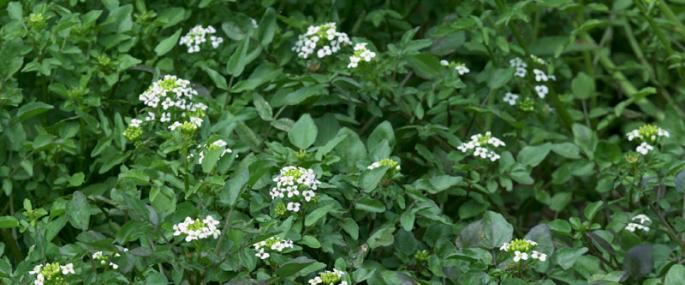
Garlic Mustard
Garlic Mustard, also commonly known as 'Jack-by-the-hedge', likes shady places, such as the edges of woods and hedgerows. It can grow to over a metre tall and has small white flowers that appear from April to June. It is a biennial plant (taking two years to complete its lifecycle), growing young leaves in its first year, which it keeps over winter, and flowering in the spring of the second.
The Wildlife Trusts manage many woodland nature reserves sympathetically for a range of spring flowers, from tasty Garlic Mustard to fragrant Ramsons, showy Bluebells to delicate Wood Anemones. A mix of coppicing, scrub-cutting and ride maintenance open up the woodland floor to the sun, helping many flowers and plants to thrive. You can help too: volunteer for your local Wildlife Trust and you could be involved in everything from traditional forest crafts to raising awareness about woodland wildlife.
Hedge Mustard
Loved by caterpillars, Hedge Mustard grows in hedgerows, on roadside verges and on waste ground, preferring disturbed ground. Small yellow flowers appear from May to October and tangled, wiry stems.
Although they sometimes don't look especially wildlife-friendly, our roadside verges, field edges and waste grounds can provide valuable habitats for all kinds of plants and animals. The Wildlife Trusts get involved in different projects to help make these places as beneficial for wildlife as possible. We have a vision of a 'Living Landscape': a network of habitats and wildlife corridors across town and country, which are good for both wildlife and people. You can support this greener vision for the future by joining your local Wildlife Trust.
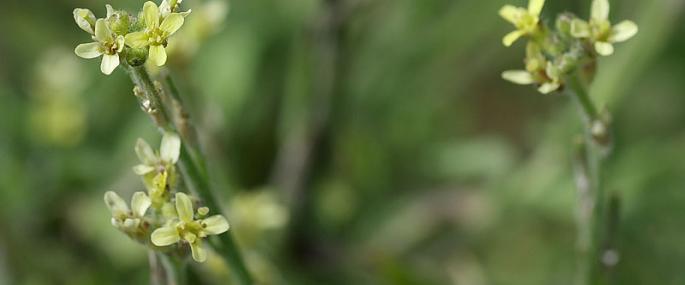
Round-leaved Sundew
Windswept heaths and moors are an iconic feature of the UK's landscape and are the result of hundreds of years of low-impact human activities such as livestock-grazing and scrub clearance. Yet development and the decline of traditional farming methods have caused many of these precious habitats to be lost - over 80% of lowland heathland in the UK has disappeared in just 200 years. The Wildlife Trusts manage many heathland habitats for the benefit of wildlife such as the Round-leaved Sundew. By volunteering for your local Trust you can help too, and you'll make new friends and learn new skills along the way.
Field Pansy
The delicate Field Pansy is a wild relative of our garden pansy and can be found in fields and on waste ground and roadside verges - anywhere the ground has been disturbed. Its long-stalked, pale yellow flowers can be found winding their way through the grasses from April to October.
Although they sometimes don't look especially wildlife-friendly, our roadside verges, field edges and waste grounds can provide valuable habitats for all kinds of plants and animals. The Wildlife Trusts get involved in different projects to help make these places as beneficial for wildlife as possible. We have a vision of a 'Living Landscape': a network of habitats and wildlife corridors across town and country, which are good for both wildlife and people. You can support this greener vision for the future by joining your local Wildlife Trust.
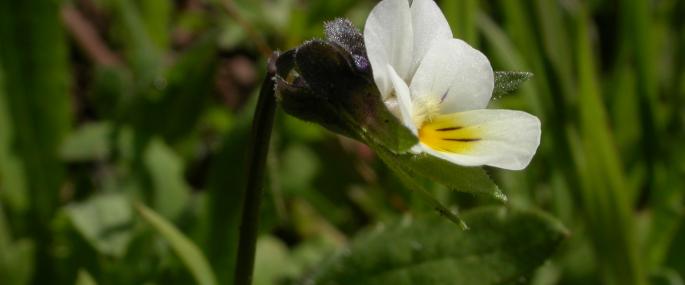
Musk Mallow
A more elegant relative of the Common Mallow, the Musk Mallow has delicate pale pink flowers and grows on roadside verges, in hedgerows, pastures and churchyards, and along the edges of fields. It favours dry places and is a popular cottage garden plant.
Although they sometimes don't look especially wildlife-friendly, our roadside verges, railway cuttings and churchyards can provide valuable habitats for all kinds of plants and animals. The Wildlife Trusts get involved in different projects to help make these places as beneficial for wildlife as possible. We have a vision of a 'Living Landscape': a network of habitats and wildlife corridors across town and country, which are good for both wildlife and people. You can support this greener vision for the future by joining your local Wildlife Trust.

Mallow
Common Mallow is a handsome, large, spreading plant with beautiful deep-pink flowers that appear from June to October. It can be found on roadside verges, alongside footpaths and on waste ground. Certain parts of Common Mallow are edible (leaves, flowers and seeds) and there is evidence that the Romans may have deliberately cultivated the plant to be used for food and medicine.
Although they sometimes don't look especially wildlife-friendly, our roadside verges, railway cuttings and waste grounds can provide valuable habitats for all kinds of plants and animals. The Wildlife Trusts get involved in different projects to help make these places as beneficial for wildlife as possible. We have a vision of a 'Living Landscape': a network of habitats and wildlife corridors across town and country, which are good for both wildlife and people. You can support this greener vision for the future by joining your local Wildlife Trust.
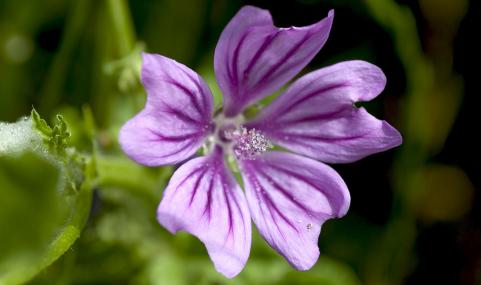
Rock-rose
Common Rock-rose is a low-growing, creeping, evergreen shrub that likes sunny chalk grassland, cliffs and rocks. It flowers from June to September and can grow in dense clusters, colouring the grey-green landscape bright yellow. Common Rock-rose provides plenty of nectar for various bees and is also the foodplant of several species of butterfly such as the Brown Argus, Green Hairstreak and rare Silver-studded Blue.
The Common Rock-rose is characteristic of chalk and limestone grasslands. Areas of rare and unique wildlife, chalk grasslands have been likened to rainforest for the diversity of species they hold. But they are being lost at an alarming rate due to changes in land use causing the decline of grazing: it's estimated that we've lost 80% of our chalk grassland over the last 60 years. The Wildlife Trusts manage many grassland nature reserves for the benefit of the rare wildlife they hold. You can help too: volunteer for your local Wildlife Trust and you could be involved in everything from scrub-cutting to stockwatching.
Sea-lavender
Common Sea-lavender grows in muddy, salty pools or saltmarshes along the coast. Its flowers range in colour from blue through to lilac and pink, and can often be seen densely carpeting the ground from July to October. Garden varieties of this plant are popular with flower arrangers as the flowers can be dried and keep their shape and colour.
The Wildlife Trusts look after many coastal habitats for the benefit of plants like Common Sea-lavender, and are working closely with farmers, landowners and developers to promote wildlife-friendly practices in these areas. We have a vision of a 'Living Landscape': a network of habitats and wildlife corridors across town and country, which are good for both wildlife and people. You can support this greener vision for the future by joining your local Wildlife Trust.
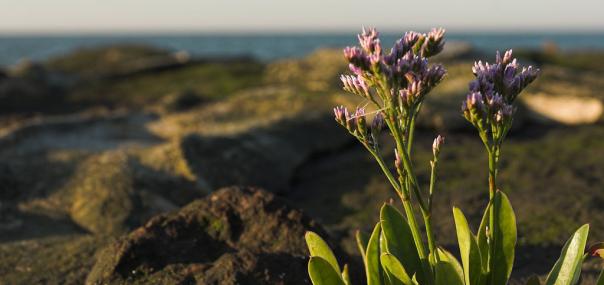
Hop
Hop is a sun-loving climbing plant that is most famous for its role in beer-making. It rambles through woodland, field edges, hedgerows and waste ground, growing in sunny areas. Hop bears male and female flowers on different plants: the male flowers are small, but the female ones are like large, scaled apples and are unmistakeable. Glands within these flowers contain essential oils and have a distinctive, yeasty-garlic smell.
The loss of many of our hedgerows in the countryside mean that ornamental shrubs and hedges in our gardens provide vital food and shelter for a range of wildlife including butterflies, birds and small mammals. To encourage wildlife into your garden, try planting hedges of native species, including climbers like Hop. To find out more about wildlife-friendly gardening, visit our Wild About Gardens website: a joint initiative with the RHS, there's plenty of facts and tips to get you started.
